
Triumph’s 2024 Speed 400 and Scrambler 400 X are good, real good. One is great and the other is really good. Which is the better? You might be surprised by the answer. After riding both back to back, one of the new Indian-manufactured singles sits near the top of the best motorcycles I’ve tested in the last couple of years. Triumph’s achievement is truly remarkable. It knows the stakes for the smaller displacement space are high (this is the area where it captures new lifelong clients) and delivers.
In 2023, our UK contributor Adam Child got a “Western” exclusive (Indian media got first crack at the models in 2023) on preproduction versions of the Speed 400 and Scrambler 400 X, and his reviews were nothing short of glowing. We had to wait until 2023 to learn the full story about these bikes, but now we have it.
398cc Single DOHC Liquid-cooled
Both models have a single 398cc DOHC, liquid-cooled engine. Triumph claims that it produces 39.5 horsepower at 8,000 revs and 27.7 lb.ft. of torque when cranked up to 6,500 revs. The Speed and Scrambler can rev up to 8,000 rpm, but there’s still plenty of torque available at lower speeds. The engine is not a tap dancer, it just torques from the corner and accelerates as it revs. The Speed 400 and Scrambler 400 both enjoy living in third and forth gears on the dizzying, tight roads of Valencia, Spain.
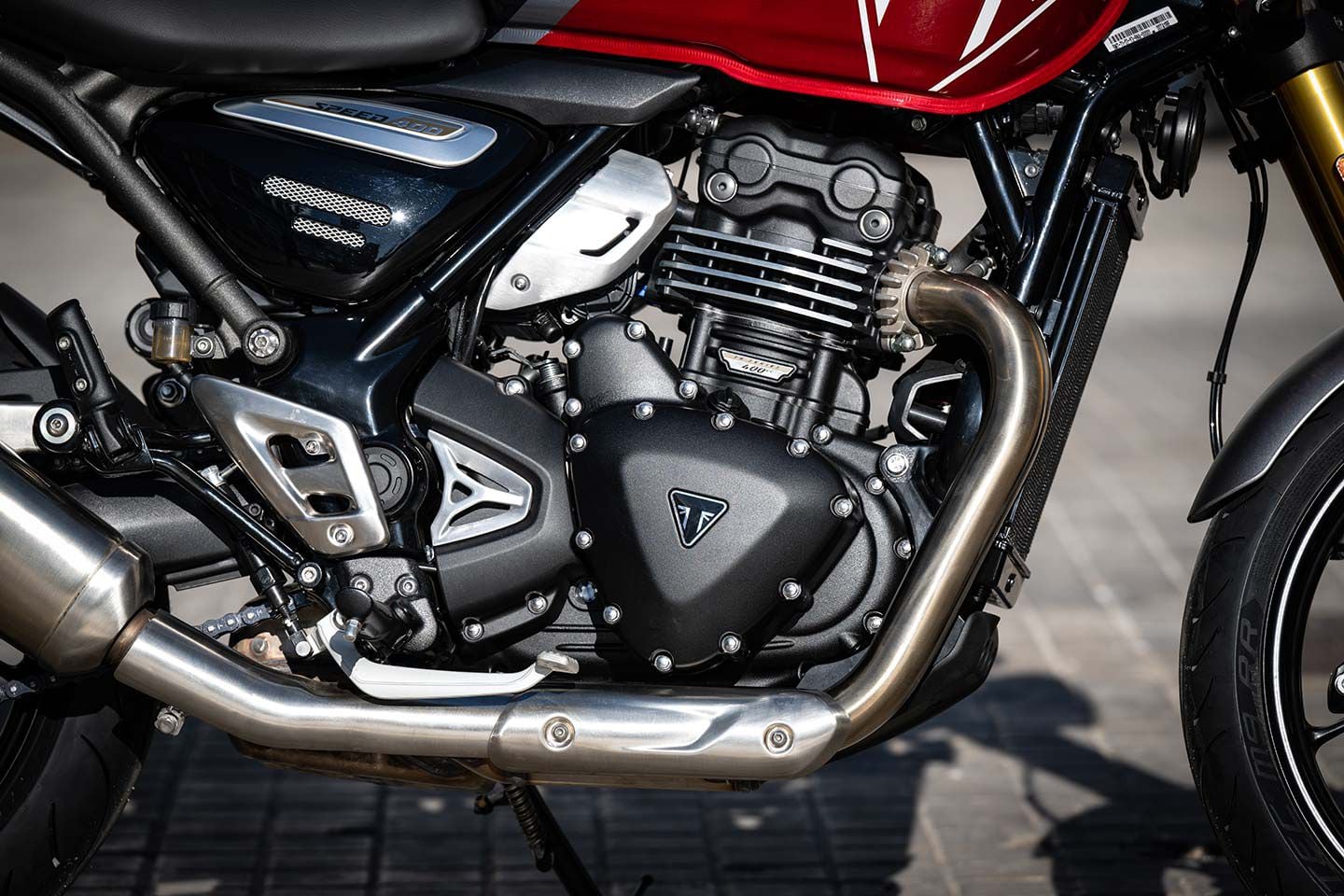
Although the final-drive ratios are slightly different, both the Scrambler X and Speed have the same vigor when moving forward, despite the fact that they are both 398cc singles. Scrambler X carries about 20 pounds more than Speed. Overall, gearing is low enough to really highlight the engine’s torque and both run out of steam just before or right at 100 mph. Give it enough space and the Speed 400 will easily click past 100 mph.
A counterrotating balance shaft controls engine vibration, though the mirrors at the end of the Scrambler’s wider bars become blurry as you approach maximum revs. The rest of the body gets just the right amount of giggle and buzz to portray a robust engine, although there is no lumpiness that would have come from a long-stroke single—think more of a twin-ish character.
Traction Control System and ABS
There are no ride modes on Triumph’s singles, but there is traction control and ABS—neither are lean sensitive. Hey, for $4,995 and $5,595, you can’t have it all. In our Speed testing, we never found the maximum amount of traction on a dry surface. There’s so much traction from the Metzeler Sportec M9 RR tires, you’d be hard-pressed to lose the rear tire on the throttle. Same can be said for the Scrambler’s Karoo Street. Connection to the rear tire through the ride-by-wire throttle is excellent when at speed, but around town there’s a bit of herky-jerky snatch that requires familiarity with the quirk and the easy-to-modulate clutch for smoothness.
It is easy to disable the traction system using the LCD display and the left-hand switch gear. The Scrambler 400X was tested on a small section of dirt during this press release, but it’s better to let the rear wheel loose on soft surfaces and fire roads. When there is no firmness on the ground, the throttle will be cut fairly sharply when you drop the hammer.
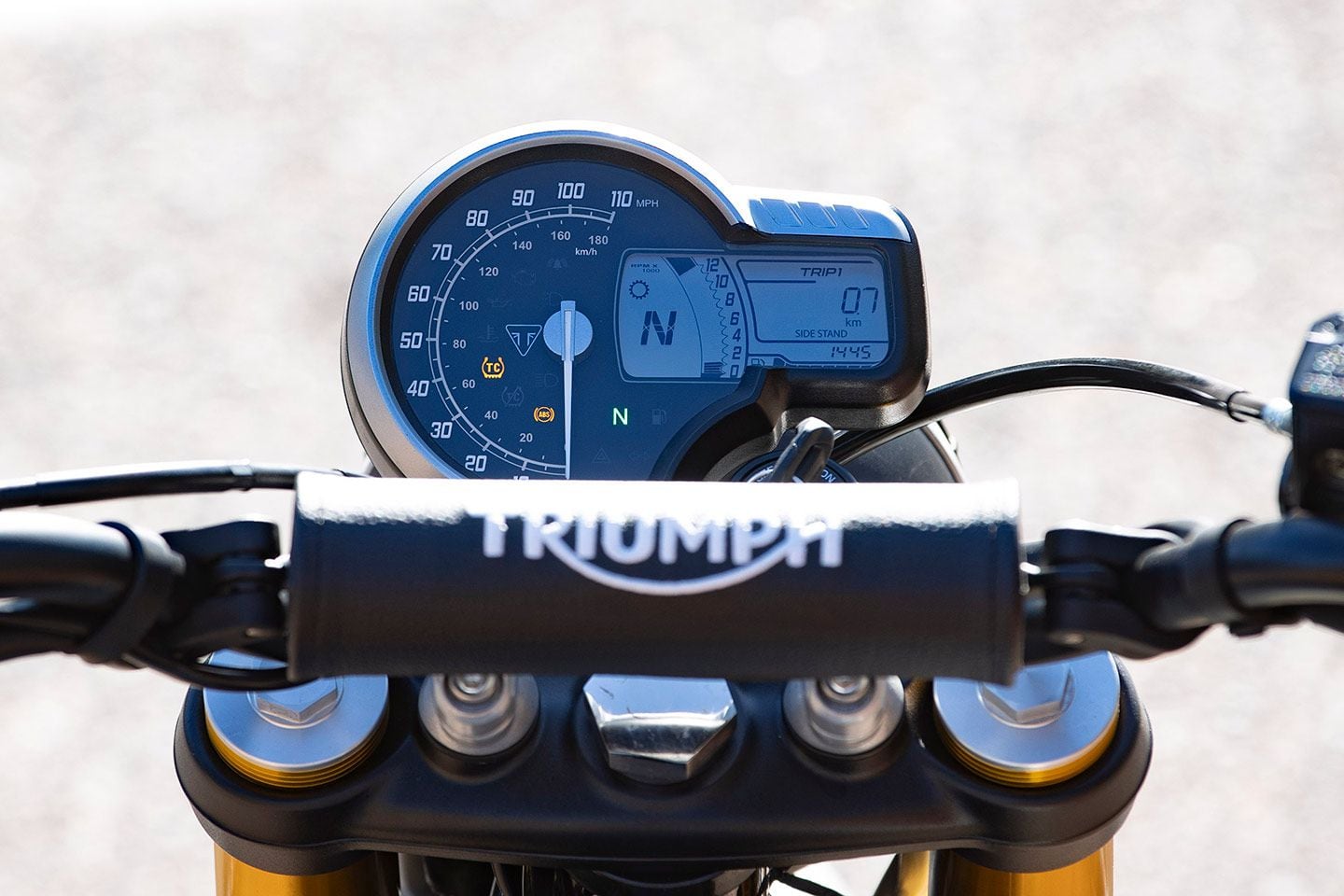
On both models dual-channel ABS is excellent and doesn’t step in until absolutely needed, which did happen a few times on the Scrambler 400 X as it has a less aggressive pad compound squeezing the 320mm front disc for friendliness in the dirt. It would be hard to notice the difference in brake feel and bite without riding the bikes back to back, but stepping from the Speed’s sportbike-strong pad compound, 300mm front disc, and radial-mount ByBre four-pot caliper to the X’s setup, the there is a difference. The vibration of the lever is a sign that the ABS has kicked in. When you stomp on the rear brake lever, a pulse is sent to your foot. This can be felt in the rear tire. Scrambler 400X’s Off-road Mode removes ABS on both ends.
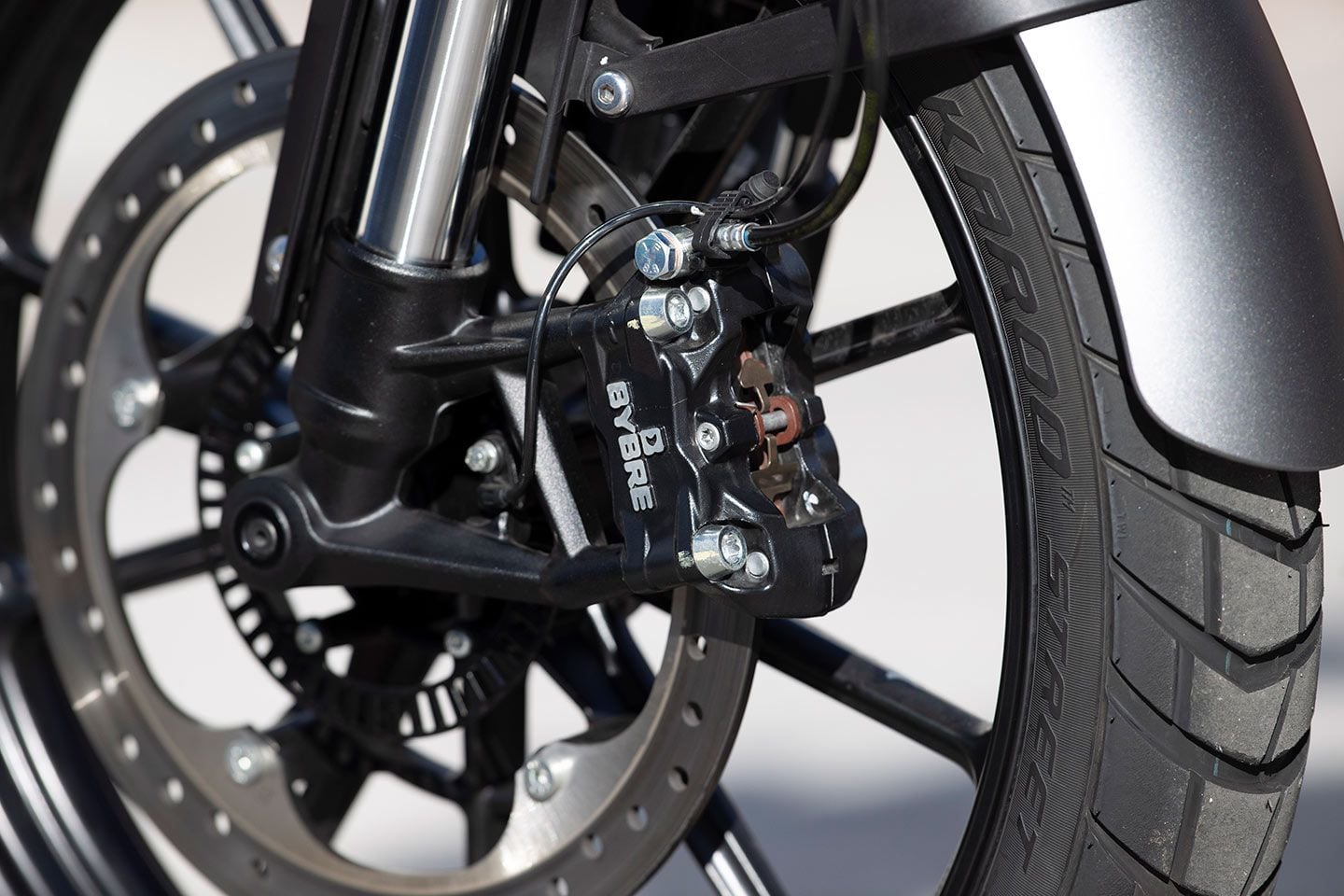
Differences between chassis
There are only a few, but very significant differences in the chassis. The Speed 400’s frame is 1 inch shorter than that of the Scrambler. The X has a longer main steel tube frame in order to accommodate the 19-inch wheel that offers more travel. Rake is 1.4 degrees steeper, at 23.2, while trail is a quarter of an inch longer, at 4.25. The suspension on both models features a nonadjustable Showa Big Piston Fork in 43mm with 5.9 inch of travel for the Scrambler 400X and 5.5 inch on the Speed 400. On the Scrambler, the monoshock is only preload adjustable. The swingarms are the same on both units, but the wheelbase of the X is 1.6″ longer. The Scrambler gets a taller and wider handlebar, as well as a number of off-road features like hand guards, skid plates, screens on the radiator and headlight, and a dual-tip upswept muffler.
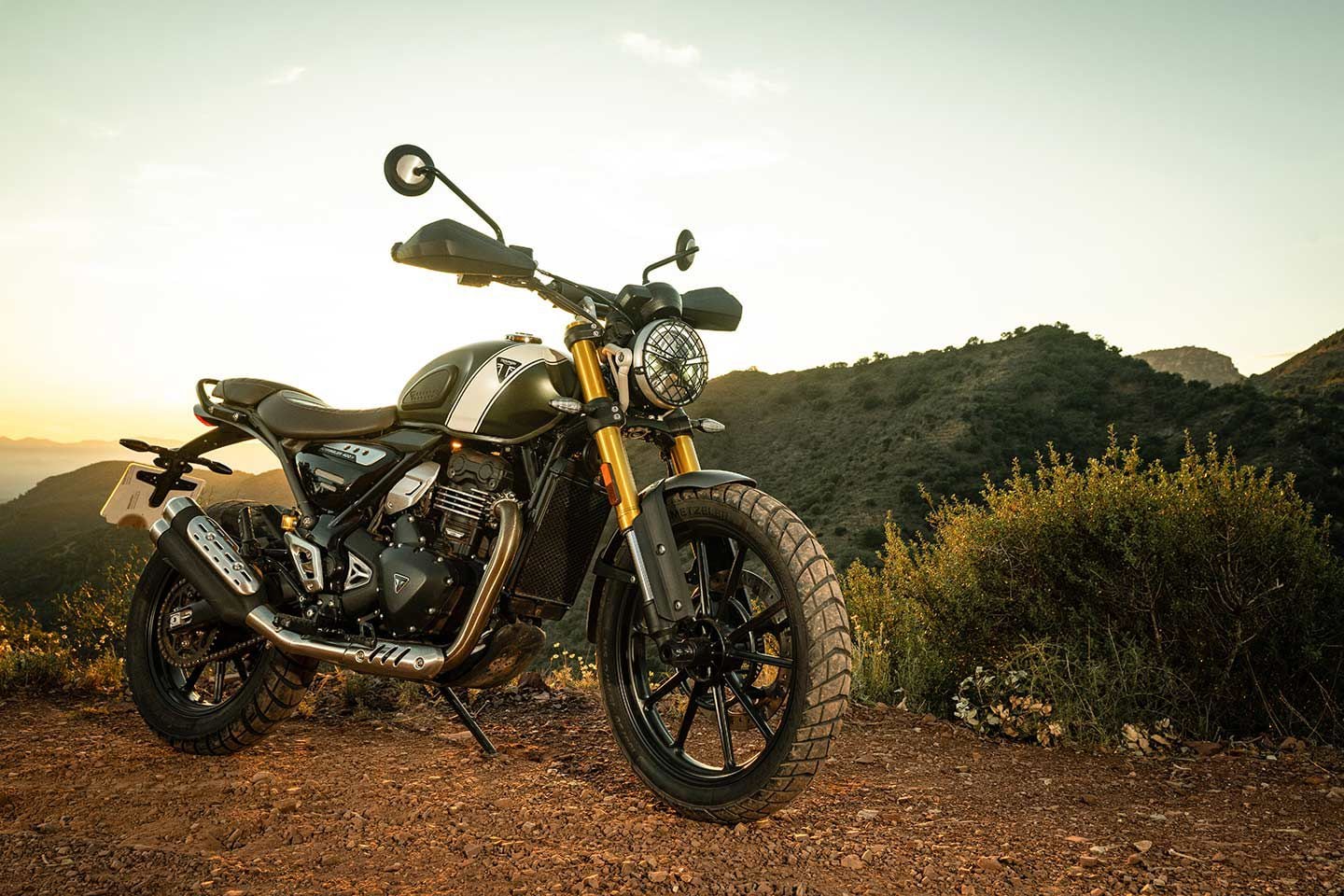
The Scrambler 400 X’s suspension is plush and eats up road imperfections and small off-road bumps. It is not going to eat whoops for breakfast, lunch, and dinner, but you wouldn’t expect it to. It will get you down that dirt road in the mountains without drama and even with a little fun—just like a scrambler should. The performance of the suspension is excellent, even though it only allows rear spring preload adjustments. There’s no fork dive when braking, and there’s no rear squat while accelerating. It’s darn near the best lower-budget suspension going—if it weren’t for the Speed 400 it might just be tops…
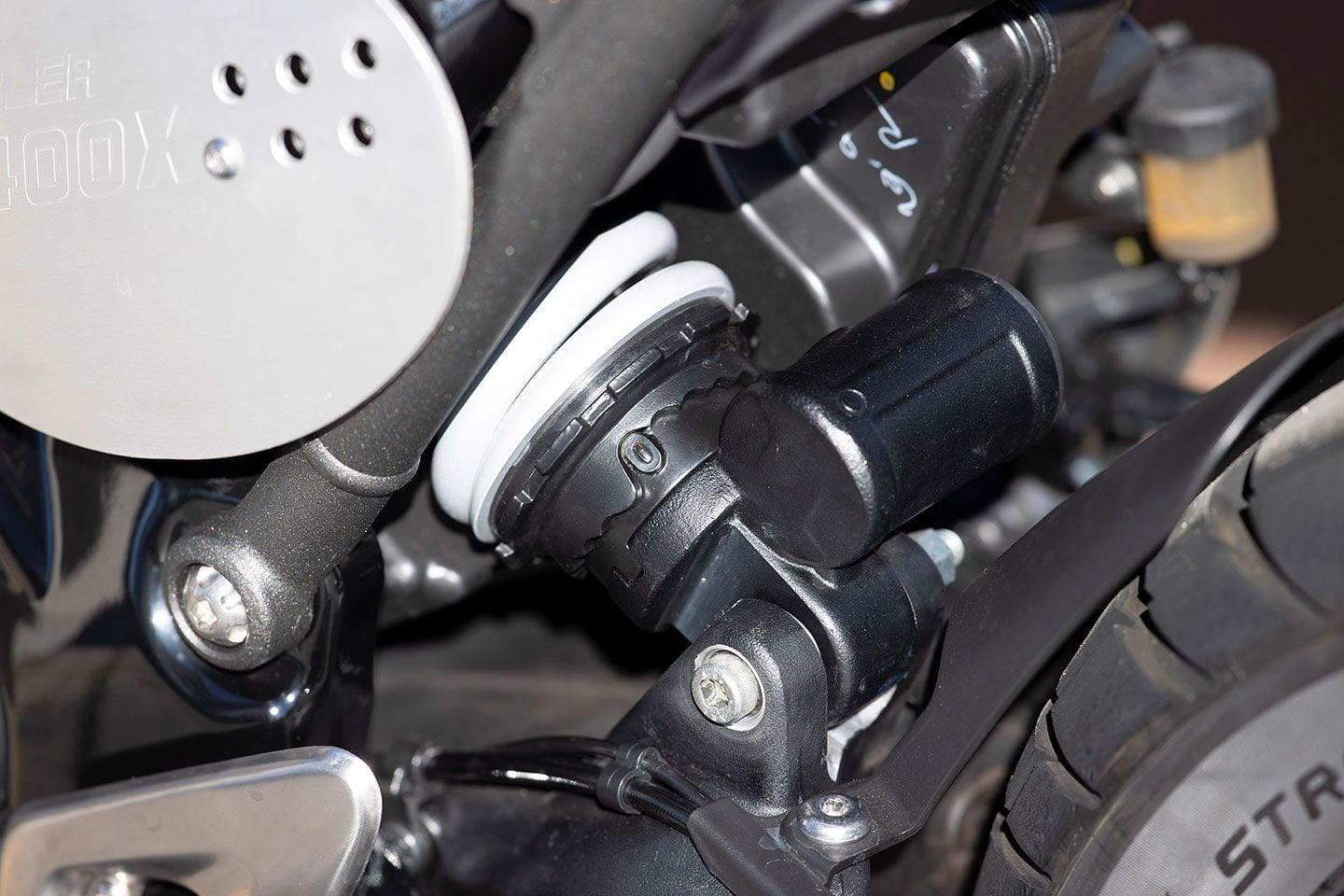
Just like the X, the Speed 400′s suspension settings are dialed in. The ride is just soft enough to be comfortable on beat-up downtown asphalt, but stiff enough—even for my 235 pounds—for a truly sporty ride. The chassis does not buck or pogo even when you are on the gas and hit a bump in the middle of a corner. How has Triumph achieved this again? The price of a motorcycle is almost beyond logic.
Handling
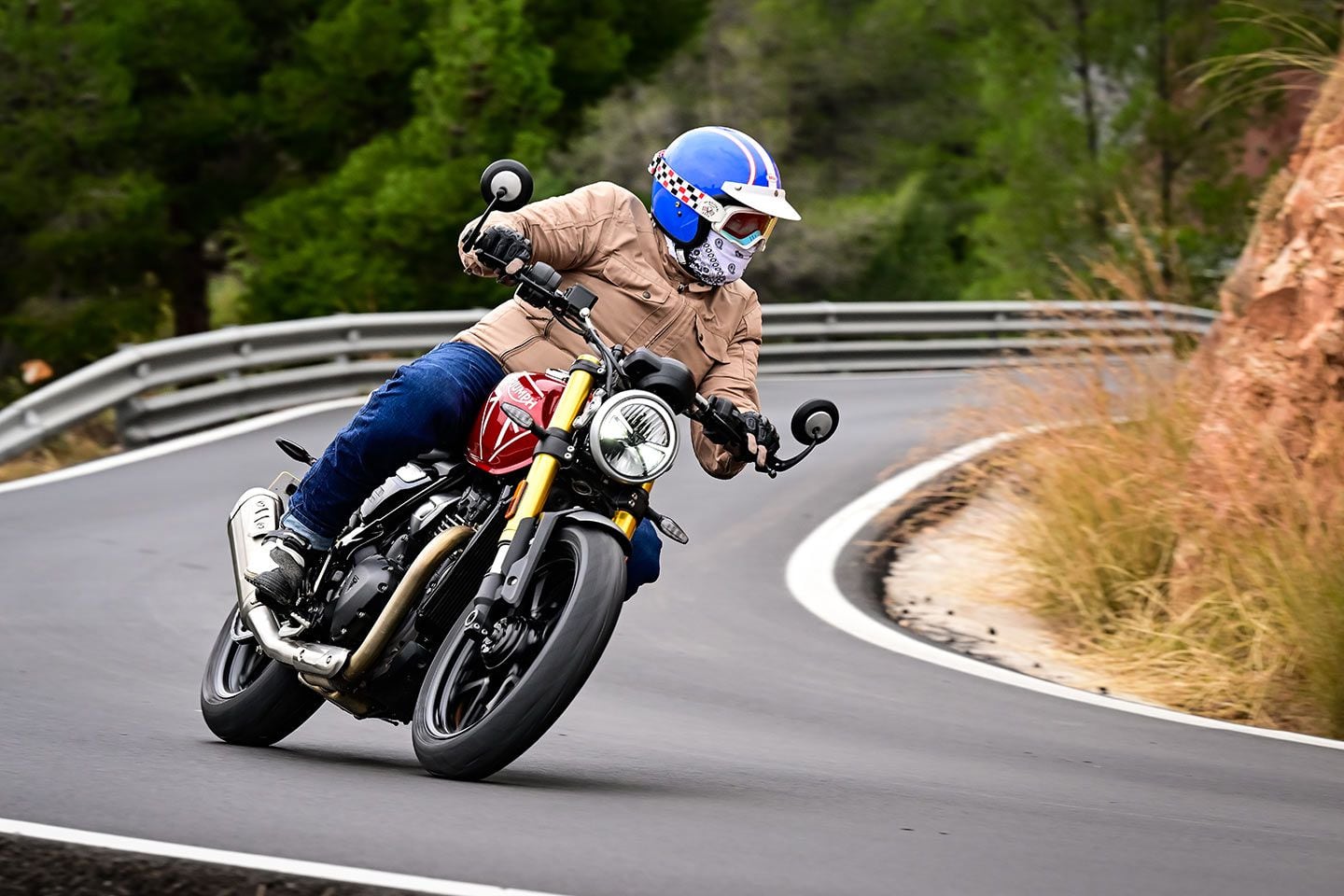
These seemingly small differences on the road translate into a totally different experience. On the Scrambler 400 X, turn-in is slightly heavy—even with those wider moto-bars. Once you’re leaned over, the bike is easy to ride. Once you’re on the Speed 400 your opinion is changed.
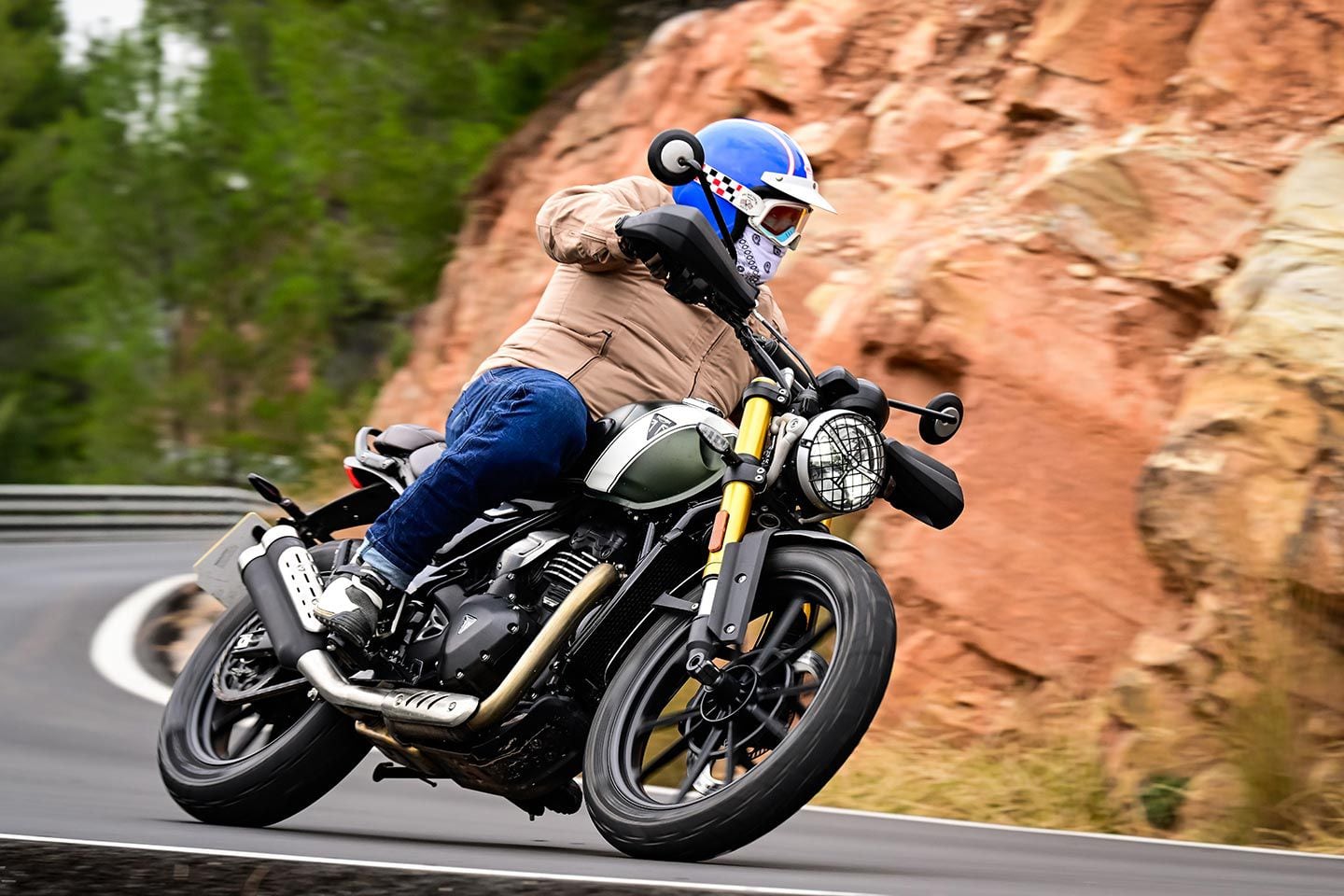
The Speed 400 lives up to its inclusion into Triumph’s Sport Classic range. Like our Best Standard motorcycles 2022 and 20, the Speed Twin 1200, the 400 is also a canyon-carving machine in disguise. Speed 400’s main features are effortless turn-in and pinpoint accuracy, as well as rock-solid stability. Sportec M9 tires give feedback that’s almost telepathic. The question was asked repeatedly and the test conducted: Does the cool factor and charm of the Speed 400 make you think it’s better than it actually is? Absolute no. It’s epic, it’s a steal, it’s a motorcycle you can grow with and perhaps never part with.
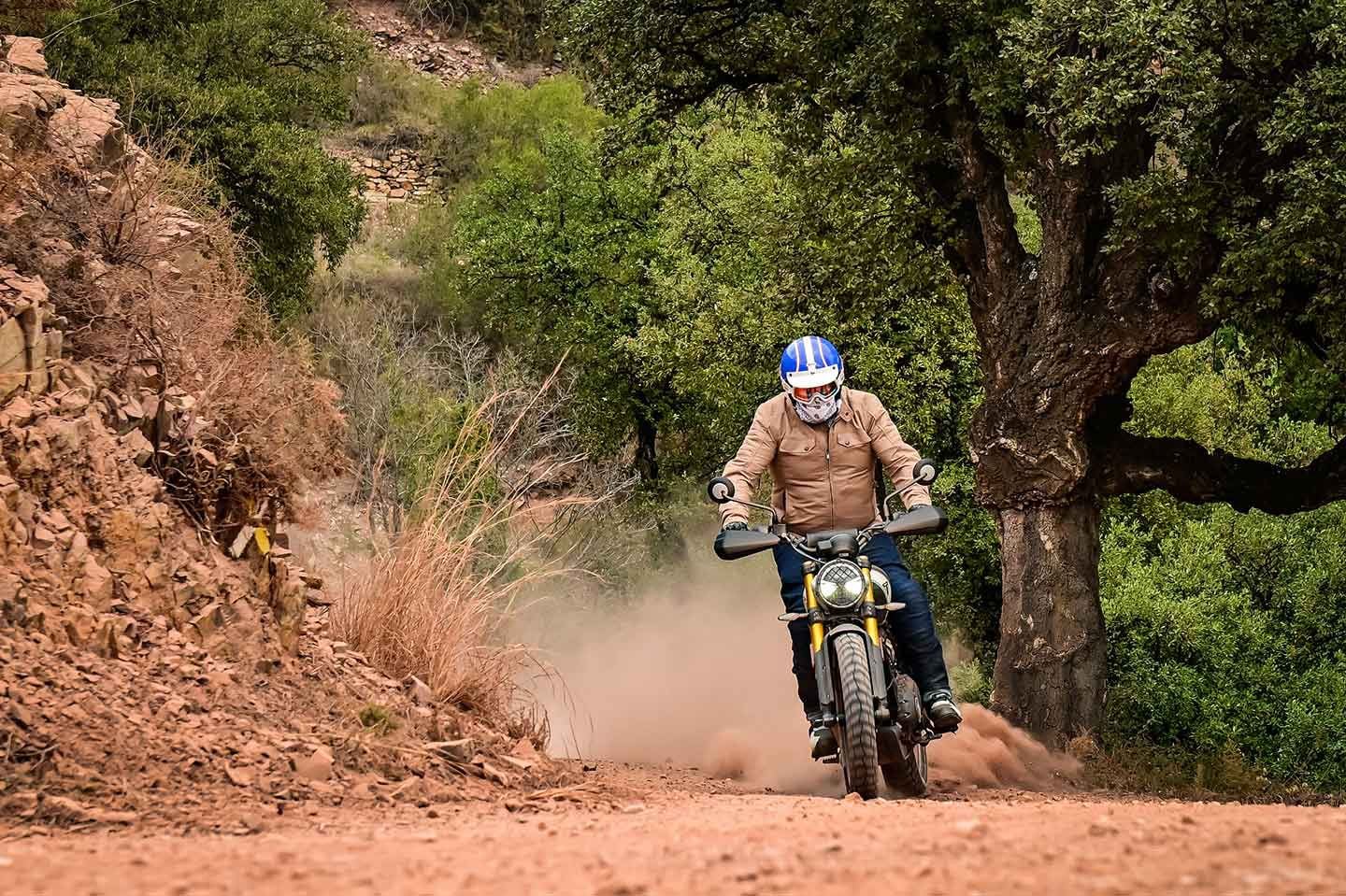
Ergonomics
The Speed has a tight, but not cramped space between the seat and footpegs. You may feel it in your knees if you are taller than 5’10”. The rest of your body won’t be affected. The seat, which is 31.1 inches high, is comfortable for all day use. The reach to the bars are slightly canted to the front but still light enough so that the wrists and the back don’t get too tired. If you need to, you can lean back and hunker but when you’re cruising around town, it is best to sit almost upright.
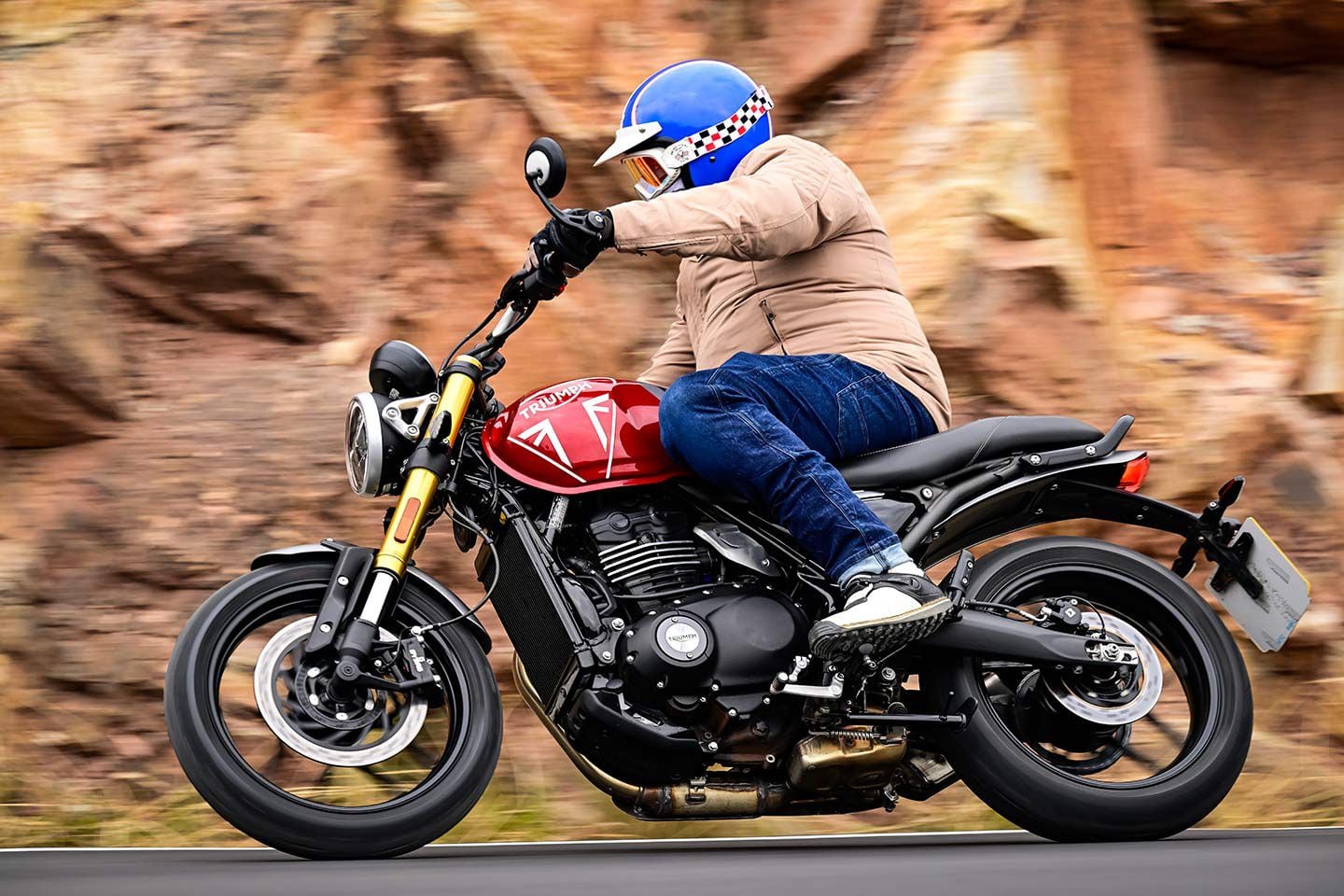
There’s more space on the Scrambler 400 X thanks to that wide and tall handlebar and footpegs that are slightly lower combined with a taller 32.9-inch seat height. If you’re taller, the dirt-slinger is the way to go while shorter inseam may struggle with getting two feet flat on the ground.
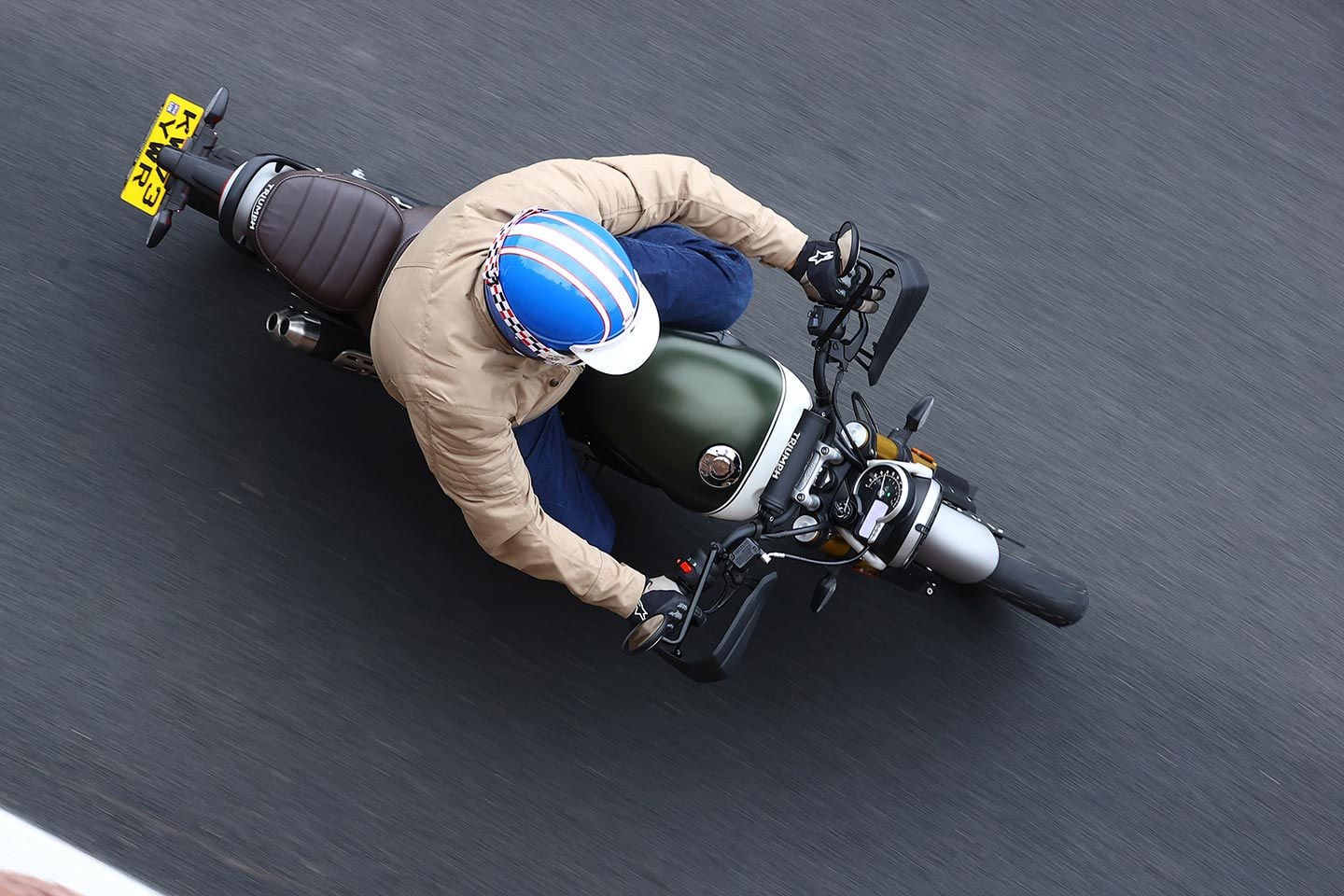
Fit and Finish
There’s no discussing a Triumph without touching on the subject of fit and finish. The brand is known for its attention-to-detail, brushed aluminium, glossy paint and high quality hardware. Both the Speed 400 and Scrambler 400X live up this reputation. Paint finishes are 90 percent of the quality you’d find on Triumphs three times the cost. Run your eyes over the hardware holding the machines together and you’ll find the same level of kit on the top-shelf Sport Classics and Scramblers.

There are only a few misses, and even those aren’t huge, one being the cheap-looking levers and the other being the banjo bolts on the brake system. Really, that’s it. Sure, they don’t have a TFT screen dash, but the LCD unit with the analog speedo gets the job done with no muss and no fuss. There’s even a USB-C plug on the side to charge your smartphone if you need navigation.
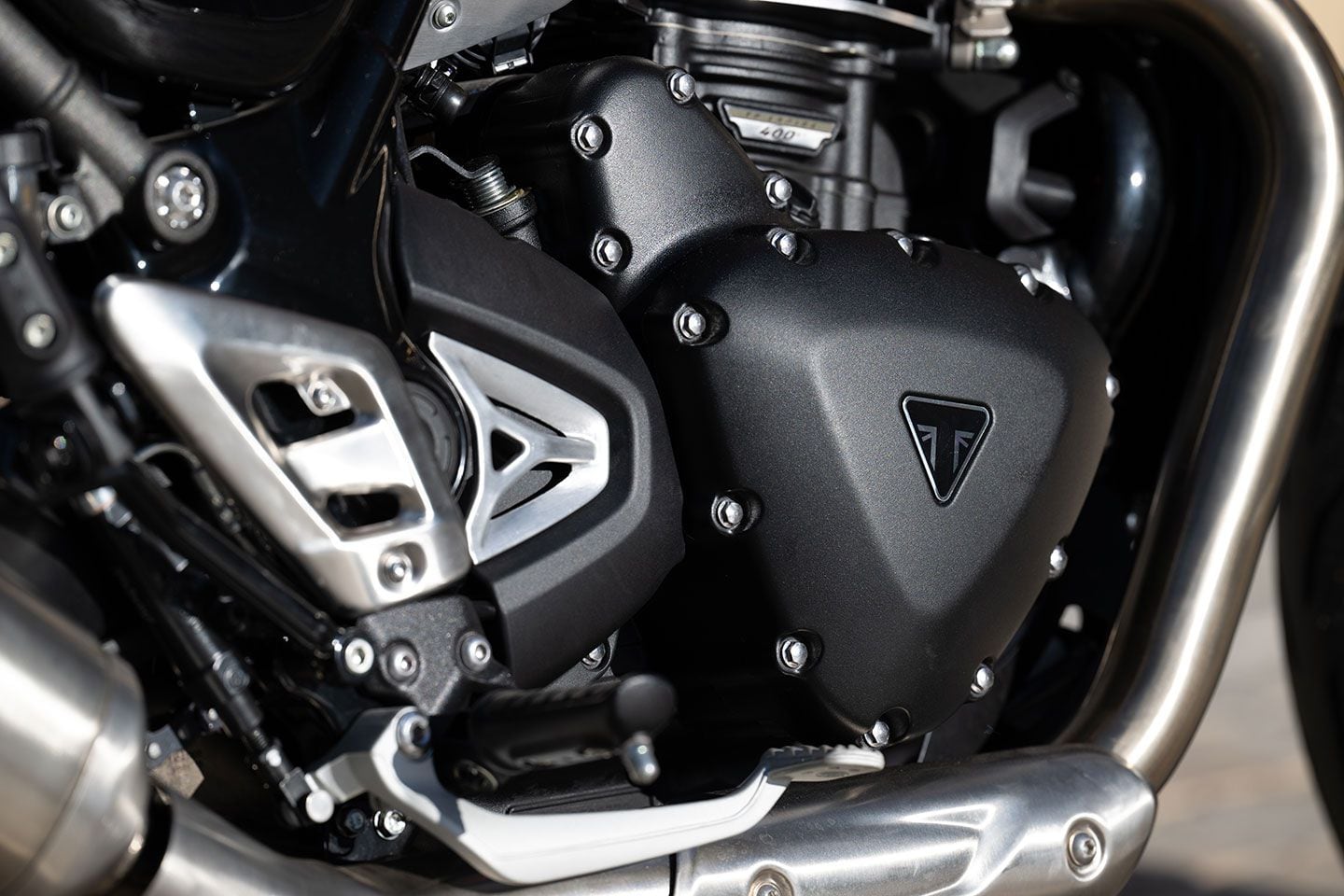
Which one is right for you?
Being so similar, you might find it hard to choose between the Speed 400 and Scrambler 400 X, but it’s rather simple and comes down to one element: dirt. If you want to venture off asphalt, it’s the Scrambler 400 X. It’s got the same great engine of the Speed, it’s roomy, and looks cool as hell. It does lose points for on-road handling when compared to its stablemate.
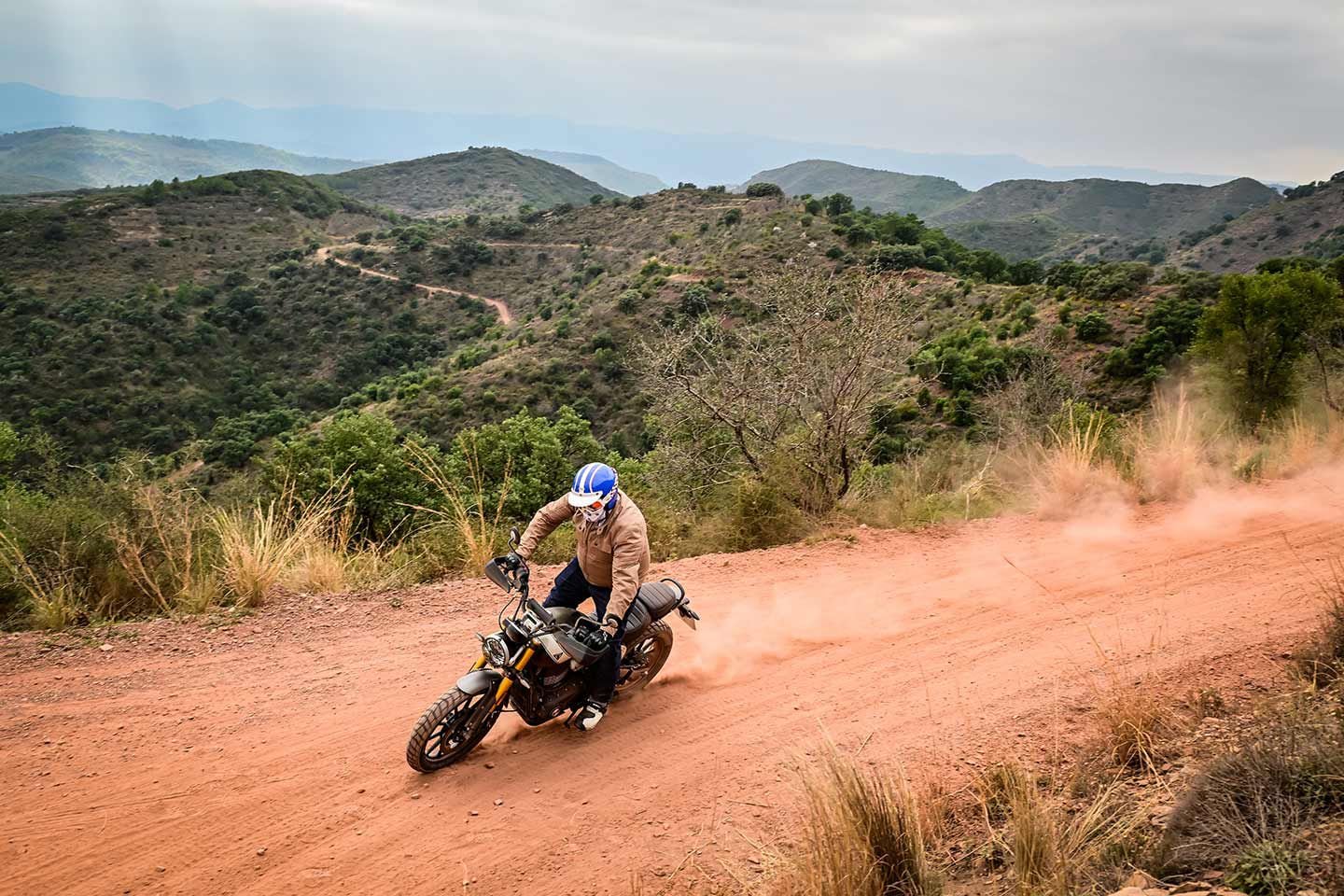
No dirt? It’s the Speed 400—without question. This is one of the greats in entry-level motorcycling; hell, it’s one of the great motorcycles of 2024. Handling is far better than it should be for a $4,995 motorcycle, the engine is punchy and fun, the ergos are comfortable, and you won’t get tired of looking at it. It’s a full package at a discount..
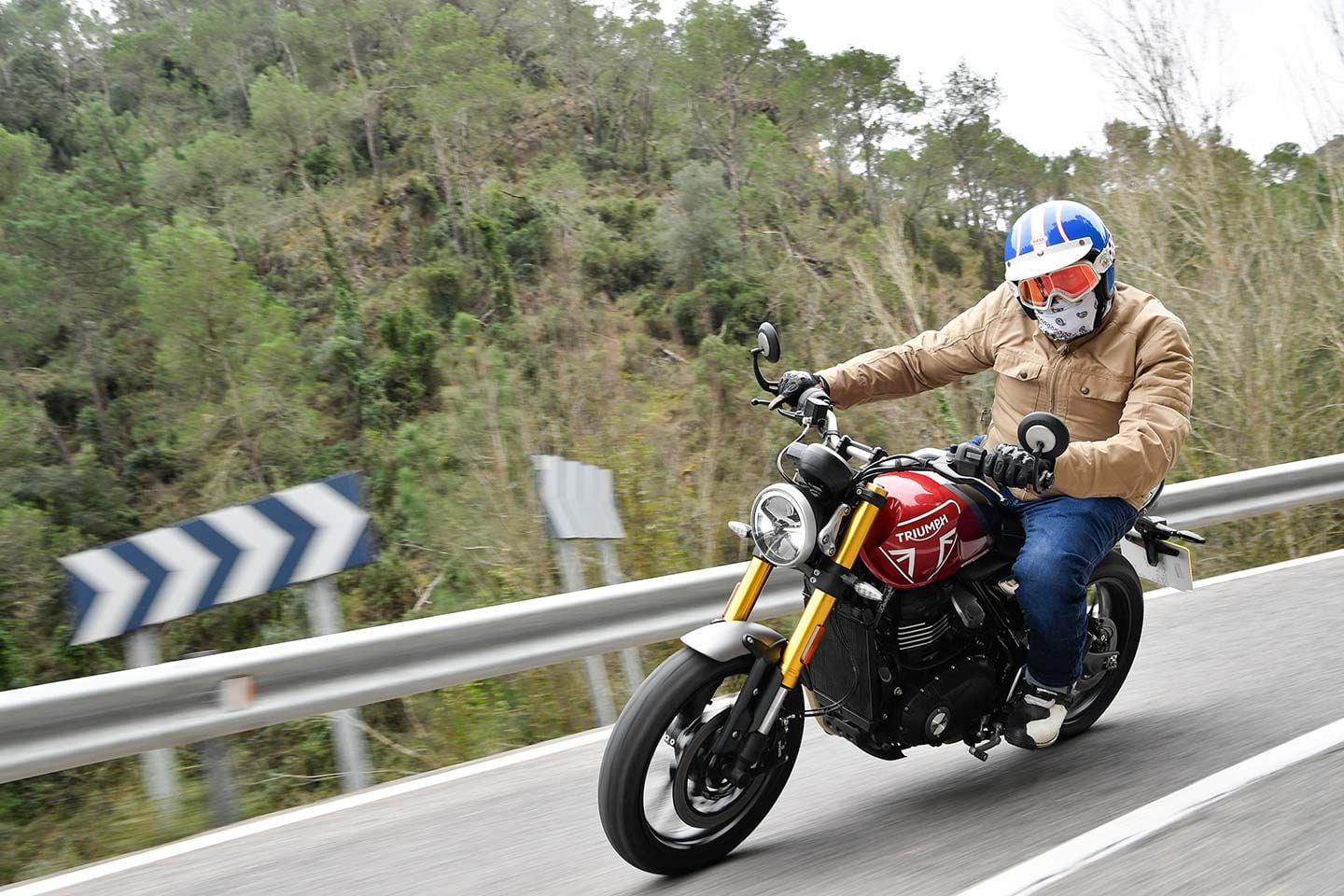
These motorcycles are Triumphs through and through and make good on the brand promise better than any other manufacturer’s entry-level motorcycles. You really can’t go wrong with either. It’s a great time to start motorcycling.
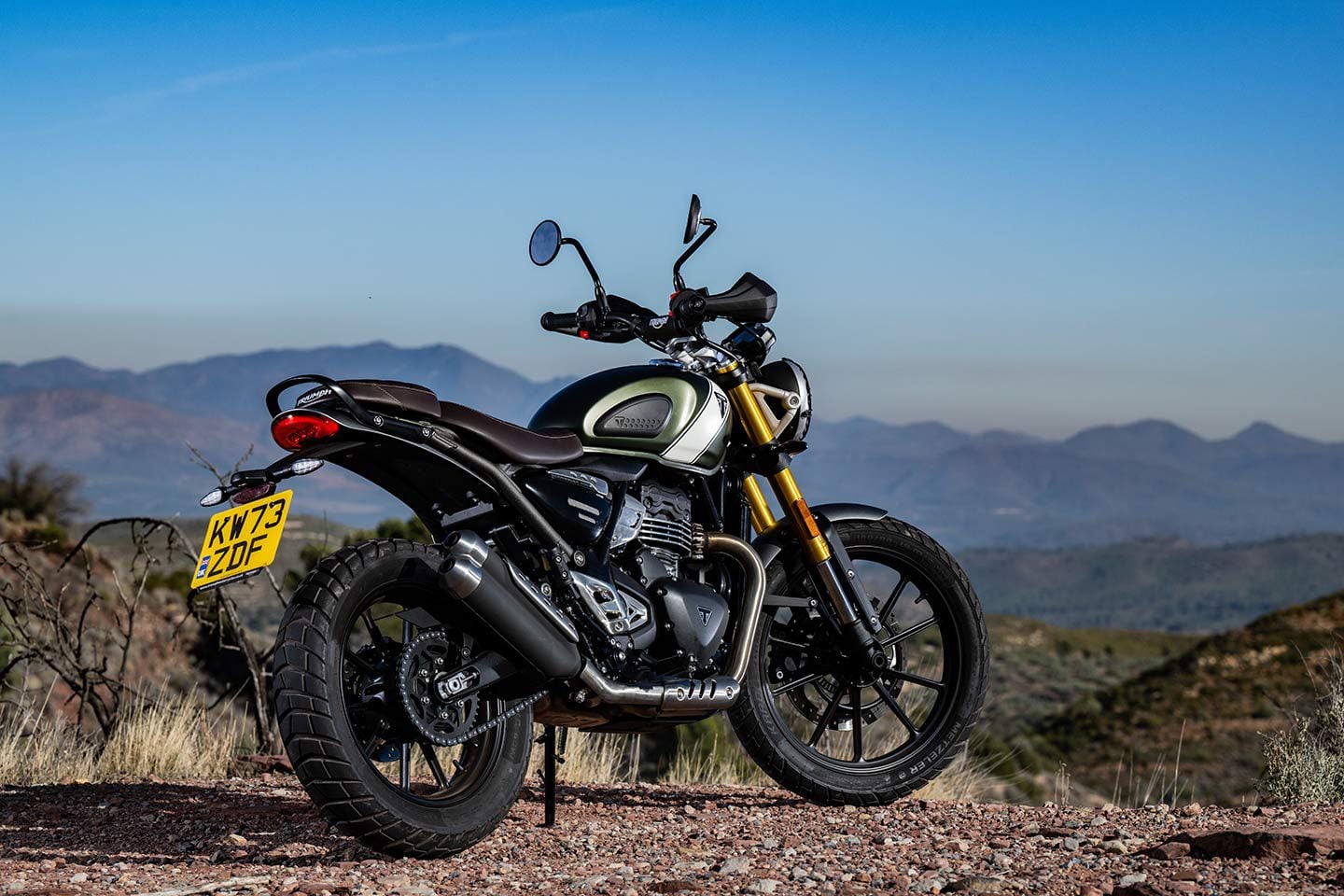
2024 Triumph Scrambler 400 X Specs
| MSRP: | $5,595 |
|---|---|
| Engine: | DOHC, single-cylinder liquid-cooled DOHC; 4 valves |
| Displacement: | 398cc |
| Bore x stroke: | 89.0mm x 64.0mm |
| Compression Ratio | 12.0:1 |
| Transmission/Final Drive: | 6-speed/chain |
| Claimed Horsepower: | 39.5 hp 8000 rpm |
| Claimed Torque: | 27.7 lb. – ft. at 6,500 rpm |
| Fuel System | Bosch electronic fuel injector with electronic throttle control |
| Clutch: | Cable-actuated, wet multiplate slipper/assist. |
| Frame: | Hybrid spine/perimeter, tubular steel; bolt-on rear subframe |
| Front Suspension | 43mm inverted Showa Big Piston Fork; 5.9 in. Travel |
| Rear Suspension | Gas monoshock w/ external reservoir, spring preload adjustable; 5.9 in. Travel: 5.9 in. |
| Front Brake | 4-piston fixed disc radial caliper 320mm with ABS |
| Rear Brake | ABS 1-piston floating disc, 230mm with ABS |
| Wheels, Front/Rear: | Cast aluminum; 19.25 x 2.5 inches 17 x 3 in. |
| Tires, Front/Rear: | Metzeler Karoo; 100/90-19 / 140/80R-17 |
| Rake/Trail: | 23.2°/4.25 in. |
| Wheelbase: | 55.8 in. |
| Seat Height | 32.9 in. |
| Fuel Capacity | 3.4 gal. |
| Claimed Wet Weight: | 395 lb. |
| Contact: | triumphmotorcycles.com |
2024 Triumph Speed 400 Specs
| MSRP: | $4,995 |
|---|---|
| Engine: | DOHC, single-cylinder liquid-cooled DOHC; 4 valves |
| Displacement: | 398cc |
| Bore x stroke: | 89.0mm x 64.0mm |
| Compression Ratio | 12.0:1 |
| Transmission/Final Drive: | 6-speed/chain |
| Claimed Horsepower: | 39.5 hp @ 8 000 rpm |
| Claimed Torque: | 27.7 lb. – ft. at 6,500 rpm |
| Fuel System | Bosch electronic fuel injector with electronic throttle control |
| Clutch: | Cable-actuated, wet multiplate slipper/assist. |
| Frame: | Hybrid spine/perimeter, tubular steel; bolt-on rear subframe |
| Front Suspension | 43mm inverted Showa Big Piston Fork; 5.5 in. Travel |
| Rear Suspension | Gas monoshock w/ external reservoir, spring preload adjustable; 5.1 in. Travel: 5.1 in. |
| Front Brake | 4-piston radial disc brake with ABS, 300mm diameter. |
| Rear Brake | Floating caliper, 230mm fixed disc w/ ABS |
| Wheels, Front/Rear: | Cast aluminum; 17×3 in. 17 x 4 inches |
| Tires, Front/Rear: | Metzeler Sportec M9 RR; 110/70R-17 / 150/60R-17 |
| Rake/Trail: | 24.6°/4.0 in. |
| Wheelbase: | 54.2 in. |
| Seat Height | 31.1 in. |
| Fuel Capacity | 3.4 gal. |
| Claimed Wet Weight: | 375 lb. |
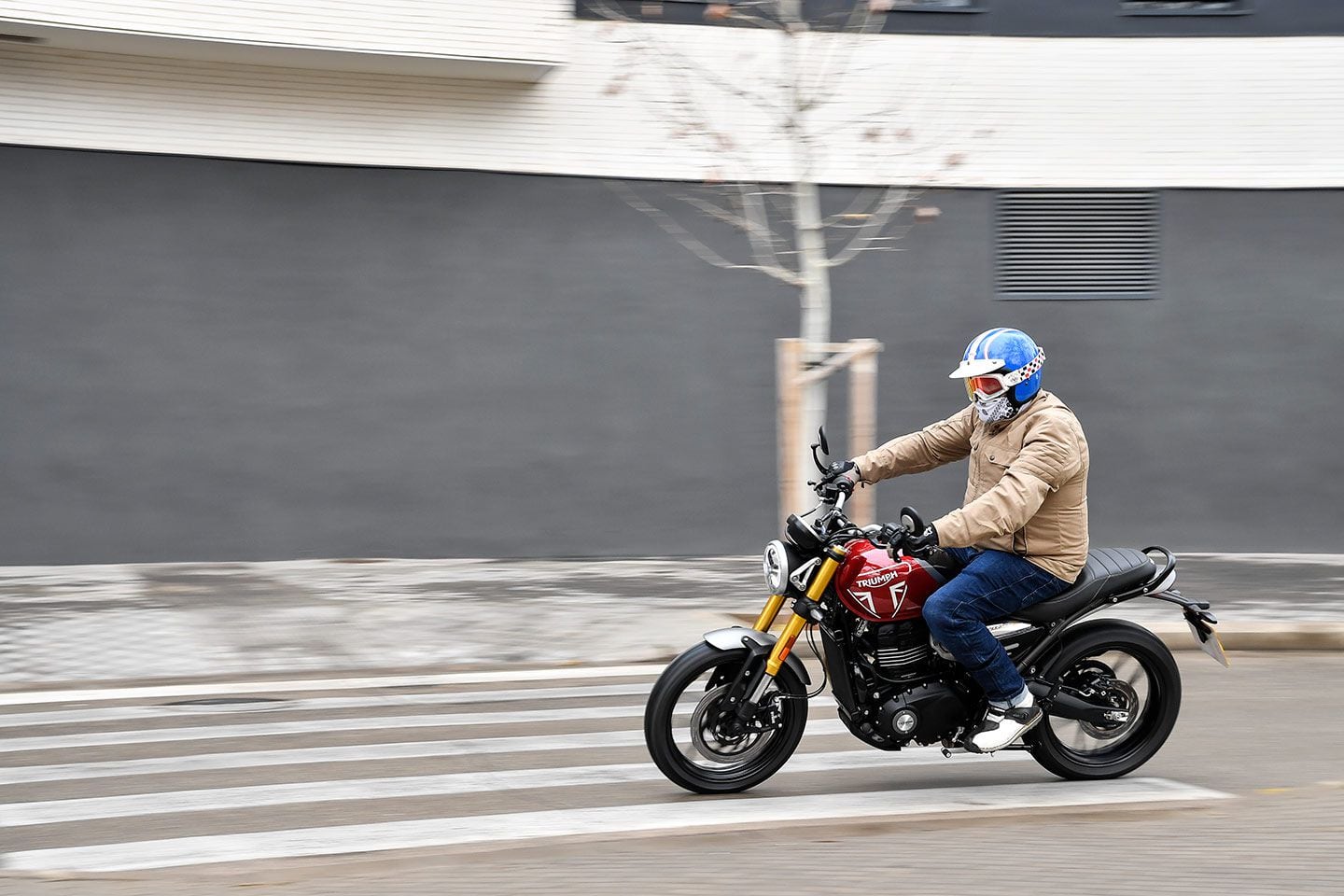
GEARBOX
Helmet Bell Custom 500 Six Day McCqueen
Jacket: Alpinestars Oscar C-10
Pant: Alpinestars Copper V2
Gloves: Alpinestars Techdura
Boots: Alpinestars tech-T
